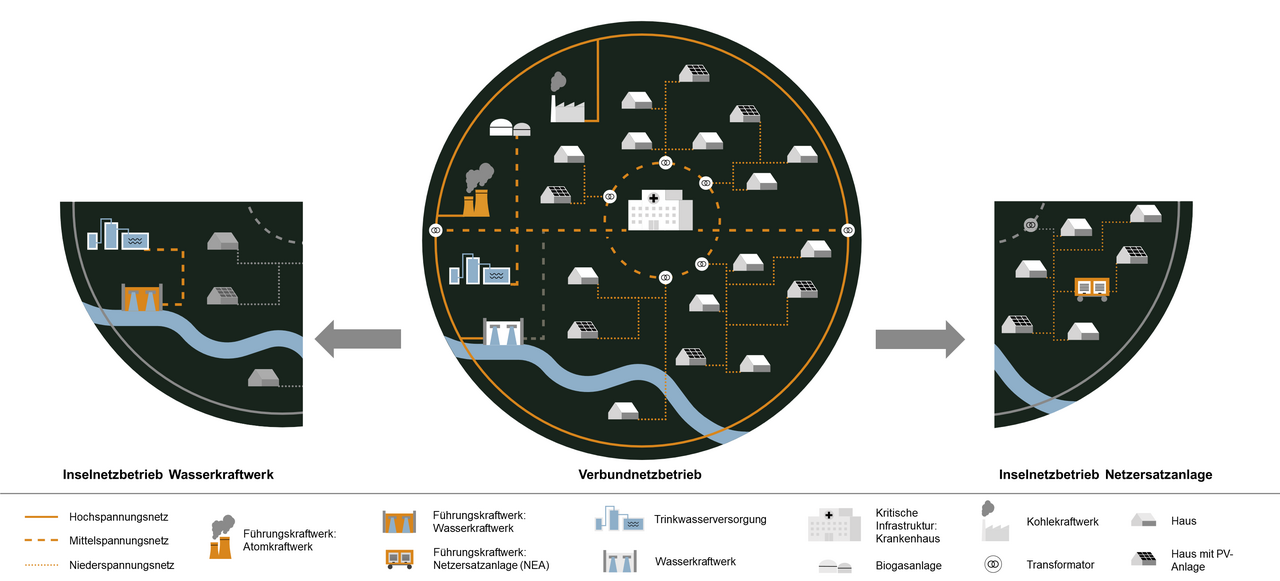Research Topics at the Associate Professorship Power Transmission Systems
- Risk assessment of electrolyser failure: Analysis of grid faults and grid-serving behavior
- LINDA 2.0
- From energy markets to network dynamics: holistic power system analysis at the TUM
- Investigation the german and european electricaltransmission systems
- Use of distributed generation for local island-system operation and accelerated network reconnection after large-scale blackout
- Smart distribution grids equipped with communicating electrical devices
- Integration von Batteriespeichern in Verteilnetze mit einem hohen Anteil dezentraler und fluktuierender Einspeiser
Risk assessment of electrolyser failure: Analysis of grid faults and grid-serving behavior
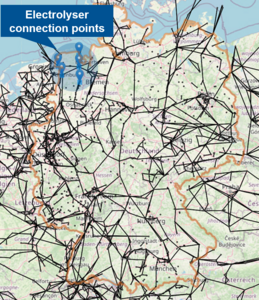
Over the next decade, the installed capacity of electrolysers will increase from a few hundred megawatts to several gigawatts. In the current coalition agreement, the German government plans to increase the capacity of electrolysers up to 10 GW by 2030. Due to the existing gas infrastructure for hydrogen and the proximity of surplus wind power, the northern German grid is expected to experience an accumulation of grid connection requests. The uncoordinated loss of several gigawatts of electrolyser load due to a grid fault poses a high risk to dynamic stability. This study provides a qualitative risk assessment of the impact of an electrolyser loss and evaluates the advantages and disadvantages of different technical requirements for grid connection.
Download the executive summary here.
LINDA 2.0 - Local (partially) automated islanding and emergency supply with decentralized generation plants in the event of large-scale power outages
The consequences of a long-lasting and large-scale power outage can be comparable to a national catastrophe with serious consequences for civil society. In such scenarios, the use of decentralized energy supply systems as an emergency supply for critical infrastructure by means of island grids can significantly reduce damage. In the research project LINDA (Local island grid supply and faster grid restoring with decentralized generation units), a concept for stable island grid operation in the event of an emergency supply was developed and tested under real conditions in a southern German grid area. In LINDA 2.0, the LINDA concept will be applied to another test area and (partially) automated. The object of investigation is a constellation of run-of-river hydro plant (islanding unit) and drinking water supply (critical infrastructure), several field tests are planned. Furthermore, a hybrid genset will be developed and tested in the distribution network during the project. This concept of a hybrid "battery power unit" offers an alternative to conventional emergency genset. Thehybrid power unit consists of a battery storage connected to a grid forming inverter, which will store power surplus coming from distributed generators. A genset will be used as range extender, to support battery capabilities. In regular operation, the range extender is switched off and the genset operates completely emission-free (noise, exhaust gas and CO2).
Further information: German project flyer
Contact: Claudia Bernecker-Castro, M.Sc., Johanna Timmermann, M.Sc.
From energy markets to network dynamics: holistic power system analysis at the TUM
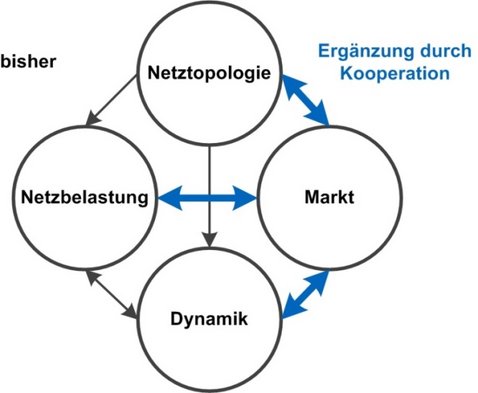
The Proffessorship for Power Transmission Systems (Prof. R. Witzmann) and the Chair for Renewable and Sustainable Energy Systems at the Technical University of Munich (TUM) cooperate together in order to offer a holistic approach to power system studies. Under the scope of the cooperation, investigations are carried out into a range of electricity system relevant topics, such as conventional power plant unit-commitment in the context of renewable energy integration, effects of distributed generation on line loading, and voltage/ frequency stability. The grid simulations are performed using an AC power flow and dynamic model of the European transmission system (ENTSO-E Synchronous Region) that is based on open source data.
Further information: Summary in PDF
See also: https://www.ei.tum.de/ens/
Contact persons: Mariano Dominguez Librandi, M.Sc., Daniel Stenzel, M.Sc.
Investigation the german and european electricaltransmission systems
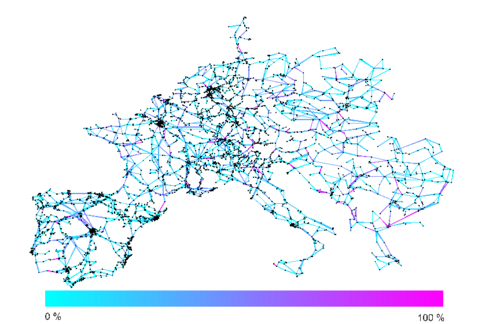
Due to the increasing levels of renewable energy integration in the interconnected European system and the subsequent geographical imbalance between supply and demand, the transmission of power over long-distances may become commonplace in the future. These power flows place significant new demands on the network infrastructure and will require the construction of new lines in order to avoid line-overloading and maintain voltages within allowable limits. Further challenges occur due to the interaction between transmission and distribution systems, whereby renewable generators connected at low voltages must contribute towards the stability of the transmission system. Using a detailed model of the transmission system, both static (load flow) and dynamic calculations are performed, allowing the analysis of system-wide line loadings (see image) and dynamic responses during fault-conditions. Through an aggregate distribution system representation, the local and global effects of distributed converter-interfaced generation on the dynamic behaviour of the german power system are investigated.
Contact persons: Mariano Dominguez Librandi, M.Sc., Daniel Stenzel, M.Sc.
Smart distribution grids equipped with communicating electrical devices
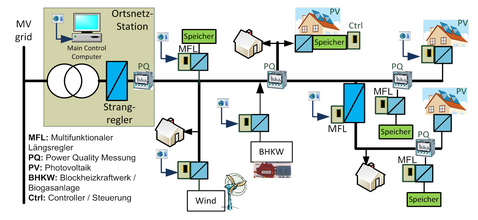
The continuously increasing amount of decentralized, renewable power generation, as well as the ever increasing use of switch-mode power supplies lead to the violation of limits (particularly harmonic distortion & admissible voltage range) specified in the technical standard DIN EN 50160. In order to reduce stress on distribution grids, whilst increasing the maximum penetration of renewable power generation and keeping a high level of power quality, it is necessary that henceforth small, decentralized power generation units are capable of providing grid services. To ensure ideal interaction between large numbers of different intelligent electrical devices (e.g. battery storages, PV-inverters, line voltage regulators, CHPs) the devices need to be connected (via broad-band powerline) to a central controller which shall be positioned at the transformer substation. The objective is to devise a reliable and practicable control strategy for the central controller. The controller and the devices will be modelled and simulated first, implemented in the smart grid laboratory afterwards and reviewed in a field test in the end.
Contact persons: Philipp Gamper, M.Sc., Antonius v. Perger, M.Sc.
